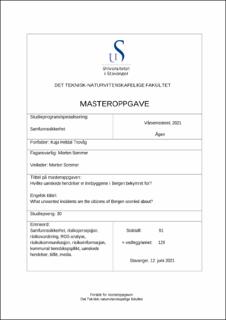| dc.contributor.advisor | Sommer, Morten | |
| dc.contributor.author | Trovåg, Kaja Heldal | |
| dc.date.accessioned | 2021-09-29T16:30:21Z | |
| dc.date.available | 2021-09-29T16:30:21Z | |
| dc.date.issued | 2021 | |
| dc.identifier | no.uis:inspera:79015646:48796639 | |
| dc.identifier.uri | https://hdl.handle.net/11250/2786346 | |
| dc.description.abstract | I en verden hvor det i større grad ønskes at innbyggerne tar del i den nasjonale beredskapen, kreves det økt risikoforståelse hos innbyggerne. Befolkningens opplevelser og tolkninger av ulike risikoer, kalt risikopersepsjon, er viktig for landets samfunnssikkerhet. Formålet med denne studien er å undersøke hvilke trusler innbyggerne i Bergen kommune er bekymret for, samt risikokommunikasjonen mellom innbyggerne og kommunen, med utgangspunkt i kommunens ROS-analyse. Studiens problemstilling er «Hvordan er sammenhengen mellom innbyggerne i Bergen sin risikopersepsjon, og kommunens risikovurderinger (på bakgrunn av kommunens helhetlige ROS-analyse)?». Det teoretiske grunnlaget for studien inkluderer risikobegrepet, risikopersepsjon, risikovurdering, og risikokommunikasjon.
Studiens datagrunnlag inkluderer en digital spørreunderundersøkelse med 562 respondenter fra Bergen kommune, i tillegg til et intervju av to sentrale aktører innen risikostyring i kommunen. Det er gjennomført kvantitative og kvalitative analyser, inkludert deskriptiv statistisk analyse, uavhengige t-tester, variansanalyser, korrelasjonsanalyser, samt tematisk analyse.
Analysene viste at innbyggerne i Bergen kommune er mest bekymret for pandemi, mens de er minst bekymret for jordskjelv. Respondentene rapporterte at de for det meste får informasjon om risikoer knyttet til de ulike uønskede hendelsene, fra media. Korrelasjonsanalysene viste flere signifikante sammenhenger mellom det å ha fått informasjon fra media, kommunen, og det å ikke ha fått informasjon, med hvor bekymret innbyggerne er for de ulike uønskede hendelsene.
Konklusjonen peker på at innbyggerne i Bergen har lik risikoforståelse som risikostyrerne i kommunen. Innbyggerne har dermed et tilfredsstillende risikobilde av bysamfunnet. Mer informasjon fører til at innbyggerne blir mer bekymret, samtidig som det å ikke ha fått informasjon, fører til at innbyggerne uttrykker at de er mindre bekymret for uønskede hendelser. Tilnærmingen av risikokommunikasjon som Bergen kommune synes å benytte seg mest av, er kommunikasjonsprosess, samt sosial forsterkning. Likevel viser resultatene at Bergen kommune ikke har kunnskap om innbyggernes forståelse av risiko, på bakgrunn av at de ikke benytter seg av toveis risikokommunikasjonsprosess. | |
| dc.description.abstract | In a world where it is a greater desire for citizens to take part in the national emergency preparedness, an increased understanding of risk by the citizens is required. The population's experiences and interpretations of various risks, called risk perception, are important for the country's social security. The purpose of this study is to investigate which threats the citizens of Bergen are concerned about, as well as the risk communication between the citizens and the municipality, based on the municipality's RVA (Risk and Vulnerability Analysis). The study's research question is "How is the connection between the citizens of Bergen's risk perception, and the municipality's risk assessments (on the basis of the municipality's comprehensive RVA)?". The theoretical background for the study includes the concept of risk, risk perception, risk assessment, and risk communication.
The study's data includes a digital survey with 562 respondents from Bergen, in addition to an interview of two key persons in risk management in the municipality. Quantitative and qualitative analyzes have been performed, including descriptive statistical analysis, independent t-tests, analysis of variance, correlation analysis, and thematic analysis.
The analysis showed that the citizens of Bergen are most worried about pandemics, while they are least worried about earthquakes. The respondents reported that they mostly receive information about risks associated with the various unwanted incidents, from the media. The correlation analysis showed several significant connections between having received information from the media, the municipality, and not having received information, with how worried the citizens are about the various unwanted incidents.
The conclusion indicates that the citizens of Bergen have the same understanding of risk as the risk managers in the municipality, giving them a satisfactory risk picture of the urban community. More information leads to the citizens becoming worried, at the same time as not having received information, leads to the citizens expressing that they are less worried about unwanted incidents. The approach to risk communication that municipality seems to use the most is the communication process, as well as social reinforcement. Nevertheless, the results show that municipality does not have knowledge of the citizens’ understanding of risk, on the basis that they do not use a two-way risk communication process. | |
| dc.language | nob | |
| dc.publisher | uis | |
| dc.title | Hvilke uønskede hendelser er innbyggerne i Bergen bekymret for? | |
| dc.type | Master thesis | |
